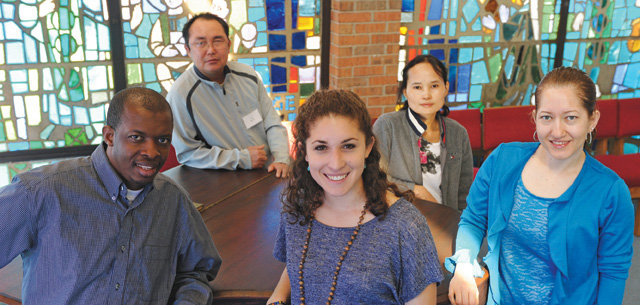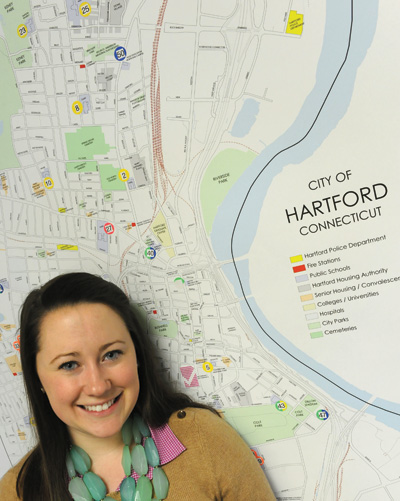These classes benefit both Trinity students and the Hartford community
by Mary Howard
Carol Clark, associate professor of economics, sees Trinity’s host city as a “powerful resource for learning.”
Clark is the faculty coordinator for the Community Learning Initiative (CLI), a program where students and community members work together to solve real-world problems in the Hartford area. “Our urban location allows for wonderful collaborations among students, professors, and community partners,” she says.
The idea of collaboration is fundamental to the initiative. “This is not a one-way street,” says Jim Trostle, Charles A. Dana Research Professor of Anthropology and faculty coordinator of CLI from 2002-2005. “We are not assuming that we have resources and the community does not.”
CLI is built on the idea that knowledge resides in many different places, not just within the college walls, says Clark. As part of CLI courses, students participate in community-based experiences that are designed together with community partners.
“Sometimes I will call [the community partner] and say, ‘I’m doing this course. Do you have any work my students can help with?’ At other times, it’s the organization that’s calling me, looking for students to participate in a particular project,” says Trostle.
In past years, students in Trostle’s medical anthropology class have interned with The
Institute for Community Research, where Trostle was a board member, and with the Hispanic Health Council. They’ve conducted literature reviews for grant proposals, transcribed interviews and worked as research assistants for these Hartford-based organizations. In the process, they saw medical anthropology in practice, while the organizations benefited from the students’ input.
“The ‘messiness’ of their ideas is revealed to them during community work in ways that it is not in the classroom,” says Trostle. “A central goal of community learning is better teaching and better learning.”
Founded in 1995, the initiative grew out of a tradition of grassroots faculty-community collaboration. “We saw that it could really take off here, which it did,” says Dan Lloyd, Brownell Professor of Philosophy and the initiative’s first director. “By 2002 we had generated more than 200 new or revised CLI courses, offering around 15 each semester.” On average, 50 percent of graduating seniors have taken at least one CLI course.
Anna Seidner ’13 took her first CLI course, “Art and Community,” as a first-year student. As part of the course, she volunteered at Hartford’s MontessoriMagnet School, helping a child whose behavioral issues made it difficult for him to participate in art class. A human rights and Hispanic studies major, Seidner so enjoyed the experience that she has taken the course every year since, working with the same student. The two developed a close bond, and the student’s behavior markedly improved. “He’s even able to serve as a helper in the class,” she says.
Seidner’s positive experience motivated her to look for other CLI courses. In her junior year, she took “Immigrants and Refugees” and, as part of the course, taught English
as a second language at the Hartford Public Library. “It sparked my interest in
working with immigrant and refugee populations in the future,” she says.
In the fall of her senior year, Seidner conducted weekly art groups with previously incarcerated women for her “Arts and Special Populations” class. As part of “Community Psychology,” she worked with an arts engagement group for high school students who have a parent in prison.
“These experiences are a huge part of my decision to pursue an M.S.W., and I will be well prepared for the fieldwork that is a big part of the degree,” she says.
It is easy for an academic community to feel bound within its gates, says Dina Anselmi, associate professor of psychology and CLI faculty adviser from 2005 to 2010. “Community learning reduces the idea that people outside our campus are different from us,” she says.
It also empowers students to see themselves as agents of change, not just passive learners. Emily Howe ’13, a student in Anselmi’s “Child Development” class, started a literacy program at a local school, distributing books to students and creating a pamphlet to help parents of emerging readers. The program was a success, with positive feedback from students, parents, and school administrators.
“What this says to students is that you can take a big problem, like children and poverty, and do something about it within the community. It empowers students to see themselves as activists within the academic context.” In addition to courses, CLI offers faculty
brainstorming events, course development grants, and an annual community partner
appreciation event. There is an interdisciplinary community action minor, and last year CLI launched the Community Learning Research Fellows Program.
CLI Research Fellows work with Trinity professors to design and carry out a credit-bearing
research or creative project in the Hartford area. Projects can be part of a course, internship, thesis, or independent study. As part of the program, fellows join an interdisciplinary student-faculty colloquium to develop and share their work.
In conjunction with the colloquium, Sarah Gardiner ’13 and Michael Oleskewicz ’13 evaluated education reform models to see how they might benefit Hartford’s public
school system. Their research was part of their internships with Achieve Hartford!. “[This
project] challenged us and ultimately rounded out our research, oral, and written communication skills,” says Gardiner. CLI Research Fellow and computer science major Pauline Lake ’13 created an after-school computer science class at the Greater Hartford Academy of Mathematics and Science. Using App Inventor, she had her students, grades
9 through 12, create their own application for an Android phone. “The program helped them see that learning can be fun,” she says. She hopes the experience will encourage
some of her students to consider a career in computer science, a field with many jobs but few applicants.
“These collaborations allow students to learn with and from others,” says Clark. This mutual learning is at the heart of CLI’s work.


